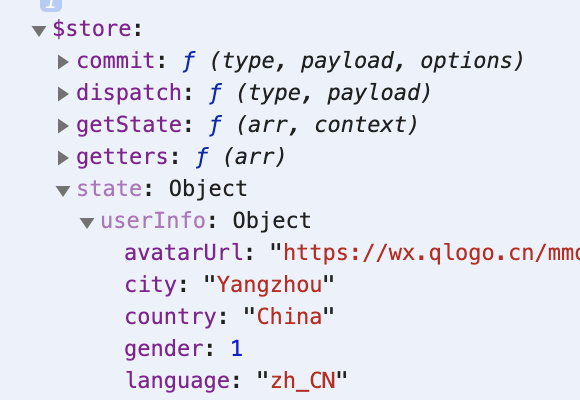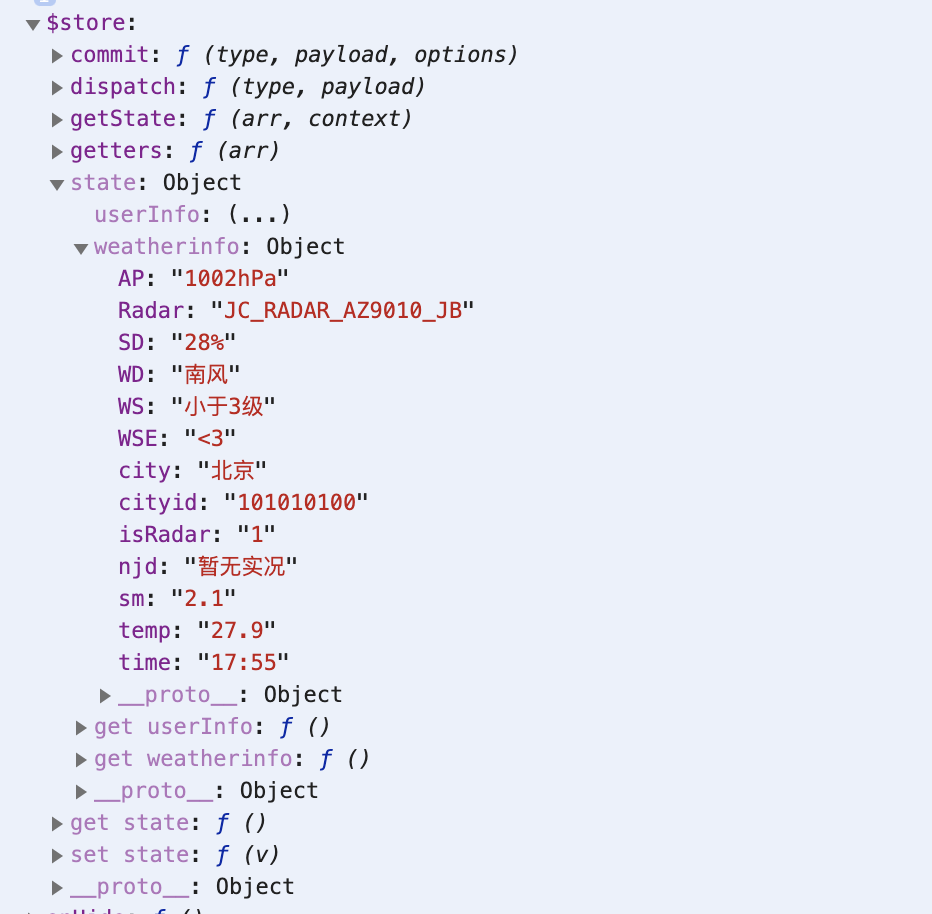微信小程序状态管理工具 JStore
闲着没事做,就想着给微信小程序写一个状态管理工具,名叫 JStore,这个状态管理工具是仿照 vuex 的几个方法来写的,所以有 vuex 的基础同学很容易理解。
Github:https://github.com/GeorgeLeoo/JStore
-
安装
在小程序根目录下新建一个 store 文件,将 jstore.js 引入小程序项目。 -
准备
在 store 中新建index.js, actions.js, mutations.js, mutation-types.js, getters.js, state.js
state.js:是一个状态管理对象,用来管理所有的状态, state中所有属性不能被直接删除或者修改,必须通过 dispatch 或 getter 方法
module.exports = {
userInfo: {},
arr:[2,4,6,8]
};
mutation-types.js:包含多个 mutation 的 type 名称的常量
export const SAVE_USER_INFO = 'save_user_info';
export const UPDATE_USER_INFO = 'UPDATE_USER_INFO';
export const SAVE_WEATHER = 'save_weather';
mutations.js: 直接更新 state 的多个方法的对象
const {SAVE_USER_INFO,SAVE_WEATHER} = require('./mutation-types');
module.exports = {
[SAVE_USER_INFO](state, {userInfo}) {
state.userInfo = userInfo;
},
[SAVE_WEATHER](state, {weatherinfo}) {
state.weatherinfo = weatherinfo;
}
};
actions.js: 通过 mutation 间接更新 state 对象
const {SAVE_USER_INFO, SAVE_WEATHER} = require('./mutation-types');
module.exports = {
saveUserInfo({commit, state}, {userInfo}) {
console.log(userInfo);
commit(SAVE_USER_INFO, {userInfo})
},
saveWeather({commit, state}) {
wx.request({
url: 'http://www.weather.com.cn/data/sk/101010100.html',
success(res) {
console.log(res.data);
let {weatherinfo} = res.data;
commit(SAVE_WEATHER, {weatherinfo})
}
})
}
};
getter.js:store 的计算属性, 只有当它的值发生了改变才会被重新计算。
module.exports = {
addTen: state => {
return state.arr = state.arr.map((val) => val * 10);
}
};
index.js: vuex最核心的管理对象
const Jstore = require('./jstore');
const state = require('./state');
const mutations = require('./mutations');
const actions = require('./actions');
const getters = require('./getters');
module.exports = new Jstore({
state,
mutations,
actions,
getters
});
在 app.js 中引入 index.js
const store = require('./store/index.js');
然后在app 的onLaunch()方法中调用store(this)将 store 注册到小程序中,以后再 Page 中直接使用 getApp().$store 获取 store 对象,其中 this 指向的是 App 对象。
假设将获取微信账户数据添加到 state 中,可以在获取数据后,使用以下方法将
getApp().$store.dispatch("saveUserInfo", {userInfo: e.detail.userInfo});
结果就将userInfo数据保存到 state 中,然后可以在页面的任意地方调用这个数据

dispatch有两个参数,第一个参数是 action 中定义的函数名,第二个参数是要保存的数据要传哪些参数给 action 中的方法,
比如获取天气数据:
在点击获取数据按钮时,执行以下这条语句
getApp().$store.dispatch("saveWeather");
结果:

当state 中有数据后,取出数据使用 getState 方法
getApp().$store.getState(["userInfo", "weatherinfo"], this);
getState()方法有两个参数,第一个参数是一个数组,数组中存放的都是state 中的 key 的名称,而二个参数是当前页面的 this 指向,如果设置了 this,就会将数据保存到当前页面的 data 中

微信小程序状态管理工具 JStore api
API参考
JStore
const store = new JStore({...options})
JStore构造器选项
state
- 类型:
object
在 store 上注册 state, state 是一个状态管理对象,用来管理所有的状态
mutations
- 类型:
{ [type: string]: Function }
在 store 上注册 mutation,处理函数总是接受state作为第一个参数,payload作为第二个参数(可选)
actions
- 类型:
{ [type: string]: Function }
在 store 上注册 action。处理函数总是接受context作为第一个参数,payload作为第二个参数(可选)。
context对象包含以下属性:
{
state, // 等同于 `store.state`
commit, // 等同于 `store.commit`
}
getters
- 类型:
{ [type: string]: Function }
在 store 上注册 getter,getter 方法接受 state 参数
JStore 实例属性
state
- 类型:Object
根状态,只读,state 内部的第一层数据也是只读的
JStore 实例方法
commit
- commit(type: string, payload?: any)
提交 mutation。
dispatch
- commit(type: string, payload?: any)
分发 action。
getState
- commit(type: array, context?: object)
获取 state。